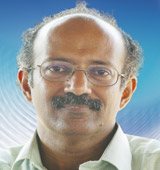|
Executive Interviews: Interview with Vivekanadan on Bottom of the Pyramid
November 2008
-
By Prema Ramachandran
 Vivekanadan
Vivekanadan Former CEO of South Indian Federation of Fishermen Societies 
- Commercialization of new boatbuilding
technologies and the
establishment of a chain of boatbuilding
centres after the initial
breakthrough in technology was
achieved by external resource
persons working with SIFFS.
- Development of a microfinance
model that is best suited to the
fisheries sector and based on the
strengths and weaknesses of the
SIFFS society model.
|
|
- Development of amethodology for
conducting a census of fishing
boats that is more accurate and
detailed than the official census and
at the same time much cheaper and
easier to implement.
- Developing the theory/concept of
the SIFFS society model as a "first
point of sale intervention" so that it can be replicated in other parts of
India and also adopted for other
commodities.
- Developing an understanding of
the issue of trans-border fishing
and putting in place a system to
release fishermen arrested for
crossing the Indo-Sri Lankan border.
vi. Acting as a key link between the
key actors in the fisheries sector of
India—SIFFS, fishermen trade
unions, scientific institutions, NGOs,
fisheries departments, international
organizations, etc.
- Fish marketing interventions
beyond the first point of sale has been
weak. Early attempts at starting direct
export of seafood by SIFFS were also
not successful. However, this seems
to be largely due to the lack of
economies of scale given that SIFFS
only controlled part of the coast and
had access to only fish caught by
small scale fishermen.
- The expansion of the society
network has been slow and weak. On
the Kerala side this has been due to
Govt policies that discouraged NGO
growth and the creation of a statesponsored
coop network in
competition to SIFFS. There were
also internal constraints that held up
the growth.
- Creation of viable district
federations has been a weak area and
SIFFS found the leadership of the
federations a major hindrance in
implementing its ideas for self reliant
and viable federations.
- Failure to address the livelihood
needs of fisherwomen though some
support has been provided for
fisherwomen organizations; similarly
inadequate attention to needs of crew
members on fishing boats.
-
The struggle for survival of the
traditional fisheries sector has
always been a mixture of social,
political and economic issues. But I
understand that you have always
kept away from the political and
social aspectswhile concentrating on
the economic issues. Was it a
conscious decision?
It was a conscious decision to keep
SIFFS an economic intervention
rather than a political or social
intervention. This was not because
the political and social interventions
were considered unnecessary or of
secondary importance. It was due to
the unique architecture of
organizations that emerged in the
fisheries sector. The activist group
that founded SIFFS also played a key
role in the emergence of this
architecture. In the late 1970s and
early 1980s, there emerged the
following set of organizations to
handle the different dimensions:
- A trade union to fight for the rights
of the fishing community;
- Women's organizations to take up
womens livelihoods and work
creatively on women's issues;
- NGOs to handle social issues,
organizing coops, unions, women's
associations, etc.
This concept of setting up different
organizations to handle different
problems has a lot of advantages
including a significantly different
basis of membership. A problem with
this strategy is that it requires NGOs
capable of organizing each type of
organization in their area of
operation. We find that this capacity
is not there. Hence, there is an
uneven development of coops, trade
unions, womens associations, etc.,
across the coast. SIFFS has always recognized that its
economic intervention, however
successful, is only contributing to
solving a multi-dimensional problem.
There has always been the awareness
that the other forms of organizations
must also be there and do their bit for
the fishing community to develop.
So, SIFFS has always maintained close relationship with NGOs, trade
unions and womens associations on
the coast. In the early days, the
leadership of the networking was
with some of the NGOs and SIFFS
just part of the larger network of
agencies. However, after many of the
founding NGOs weakened or even
shut shop, SIFFS has been playing a
stronger role in maintaining these
links. In this, I would say without
much false modesty, I have played a
key role. Even though I have been identified
with SIFFS, the fish worker trade
unions look at me as a key supporter
and resource person. I attend all
crucial sector meetings to keep the
links between the different actors.
1.
Base of the Pyramid Protocol Case Study
2. ICMR
Case Collection
3.
Case Study Volumes
|
